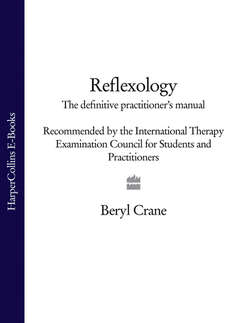Читать книгу Reflexology: The Definitive Practitioner's Manual: Recommended by the International Therapy Examination Council for Students and Practitoners - Beryl Crane - Страница 63
Palpation
ОглавлениеIn palpation a practitioner will explore by examining, touching and probing with the thumb and forefinger to find any sensitive reflexes, or feel a change in texture, such as a deposit and crunchy feeling, or an air bubble and popping sensation beneath your finger, which may indicate an imbalance within that zone. This is where astuteness and dexterity are required, also intuition and perception. Reflexologists use a unique and precise alternating acupressure technique or palpation over all areas of feet or hands to detect any imbalances. The slight changes of texture beneath the thumbs and fingers are often likened to crystalline deposits, although there is no medical evidence that this is correct, but it is enough that these ‘congested areas’ are noted by therapists. Until alerted that there is a tender area, the patient is usually unaware of overuse of a joint. The reaction may include the following: ‘Yes, I do sleep on that side’, ‘I must have at least two pillows’, ‘I always carry my bag on that shoulder’, ‘Yes, I do cross my legs as I am sitting at my desk’, ‘I always support my elbow on the window while driving’, ‘I only do the breaststroke as I do not like my hair getting wet’ or ‘I like tucking my legs up on the settee while watching television’. Such comments indicate how behaviour patterns may cause no end of problems (see below).
This process also therapeutically stimulates the nerve endings, and the soft tissue palpation has a curative effect throughout the whole zone, that is from fingertips to the brain and down to the tips of the toes. With reflexology there are many different analytical techniques; it does not matter which method is used so long as the areas are covered in a systematic fashion, and the practitioner adapts the pressure used according to the person’s needs.
During palpation the strength of the fingers and hand are felt, also the flexibility of joints are noted, and the resilience and springiness of the tissues are observed. All these are of importance in assessing the patient’s energy and vitality. Hand and nail care can often also give an insight into the person’s self-esteem. All these points need to be observed in a systematic way. The practitioner must also adopt a holistic attitude, seeing the patient as a whole. Physical, mental and social factors must be embraced and not just the individual parts of the body.
